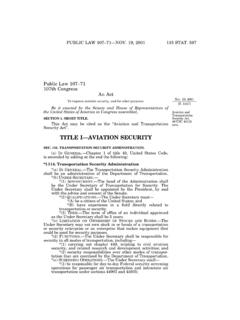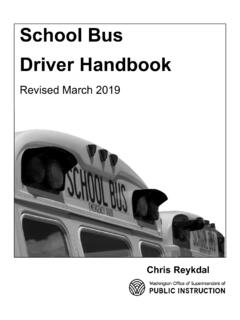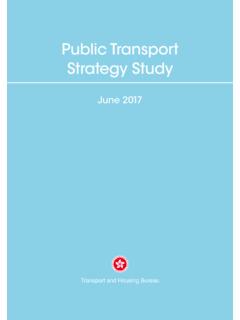Transcription of Transportation Options for Older Adults and People with ...
1 Transportation OPTIONSfor Older Adults and People with DisabilitiesChoices for Mobility IndependenceWhile driving in one s personal vehicle is undoubtedly convenient, the best way to ensure continued Transportation as we age is to become comfortable using a variety of Options . People often look to family and friends to assist with Transportation , but this may not always be possible. Community Transportation can help you stay connected to essential services and other activities. Access to reliable Transportation is a key to health and quality of life. This brochure introduces you to community Transportation services and provides information to consider when making Transportation decisions. It is intended to help you navigate Transportation in your community. It is important to note that not all types of Transportation are available in every community.
2 Local experts, such as mobility managers and information and referral specialists, can assist you in learning about the Transportation Options in your community. They are located in the public transit agency or helpful local organizations such as the Area Agency on Aging (AAA), Center for Independent Living (CIL), Aging and Disability Resource Center (ADRC) or Indian Tribal credit: The Center for Volunteer Caregiving, Cary, NC (man entering car); Ryan Byers, Pocatello, ID (man entering bus)Contact the Eldercare Locator at (800) 677-1116 or to connect to resources in your Eldercare Locator s Call Center operates Monday Friday from 9:00 to 8:00 Demand response. Sometimes called Dial-a-Ride, demand response transports multiple passengers who are picked up from different entry points and dropped off at separate destinations.
3 This service often requires reservations to be made at least 24 48 hours in advance. k Medicaid Non-Emergency Medical Transportation (NEMT) is available to persons with Medicaid to travel to and from medical services. Eligibility criteria and types of destinations vary from state to state. k public transit/fixed route Transportation . public transit agencies provide fixed route service by bus and rail along established routes with set schedules and no reservations required. Limited fixed route services may be available through other community agencies, such as trips to and from a Center for Independent Living or a senior center. k Paratransit must be offered by public transit agencies to individuals who are not able to use fixed route service. This is a requirement of the Americans with Disabilities Act (ADA).
4 Paratransit is a complement to public transit, so must operate within of a mile of the fixed route and is available during the same hours as the fixed route service. Paratransit is a door-to-door service. A personal care attendant can travel with the passenger at no cost. To qualify for paratransit, riders need to meet specific eligibility requirements established under Shared Ride Services (also known as Transportation Network Companies or TNCs) include Uber and Lyft and connect private pay passengers with drivers who provide Transportation in their own vehicles. These services do not typically offer wheelchair accessible vehicles or rider assistance. Passengers connect with drivers via websites or mobile apps on a smartphone and also pay for the services through a personal account on their phone.
5 A growing number of communities offer access to shared ride services to Older Adults and People with disabilities through a scheduling phone line which may be operated by a nonprofit organization. Half fare is available to Older Adults , People with disabilities and Medicare cardholders who use public transit/fixed route during off-peak mobility manager (sometimes called a travel counselor or another name) offers information about Transportation Options and alternatives to driving. The overall goal of a mobility manager is to help consumers choose the best Transportation option(s) to meet their individual amount of passenger assistance available from different Transportation services varies. In curb-to-curb, passengers are picked up at the curb or driveway; door-to-door passengers are assisted to enter and exit the vehicle and may be helped to the door; and door-through-door passengers are helped from the vehicle through the door of their residence or Taxi Services.
6 Taxis are licensed vehicles that offer on-demand services to passengers. Trips usually can be scheduled in advance or on the spot, and fares are charged per mile or per minute. Many communities require taxi companies to have accessible vehicles in their fleets. Some community agencies offer taxi vouchers to Older Adults and People with disabilities who meet certain eligibility Transportation Voucher Programs. Voucher programs provide fare assistance or free rides to low-income Older Adults and People with disabilities who meet the program s eligibility criteria. Eligible riders usually receive vouchers for specific types of Transportation . Voucher programs may offer rides only to certain destinations, such as medical Travel Training. public transit agencies and local aging and disability organizations provide free instruction to help new riders learn to travel safely on public transit.
7 Travel training may be provided by professionals or peers who are experienced users of public transit. The training generally includes classroom instruction plus a group trip on transit. k Volunteer Transportation Programs may be offered by local nonprofit and faith-based organizations. Drivers provide rides in their own cars or agency-owned vehicles for passengers to reach medical appointments or other important destinations. Rides are generally pre-arranged. Volunteer Transportation programs may also offer door-to-door or door-through-door assistance. Some programs require riders to pay a small fee while others offer free Options . The Transportation Options available in your community are likely to include some of the services listed below. Keep in mind that names of these services may vary depending on location.
8 Photo credit: left to right: Whistlestop Carepool, San Rafael, CA; Tri-County Action Program, Waite Park, MN; The Center for Volunteer Caregiving, Cary, NCPhoto credit: public Transportation Corporation, Indianapolis, INKey Considerations. Safe, reliable Transportation is critical. When discussing your needs, consider the following: Service Area and Trip Type: Many Transportation Options have a defined service area and set hours and days of the week when rides are available. A Transportation service may also limit services by type of trip, such as rides to medical you will need to provide: Your destination and when you need to travelAsk: What is the service area? What types of trips can be provided? Scheduling: Some services require advance reservations while others make same-day reservations.
9 Ride requests may be prioritized by urgency or type of you will need to provide: When you need to travel Whether you need one round-trip ride, or rides to multiple appointmentsAsk the provider: How much advanced notice is required? Are rides provided in the evenings, on weekends or on holidays? Will I need to wait to be picked up? If so, about how long? How do I let the driver know that I am ready to be picked up for my ride home? What is the cancellation policy?Eligibility: Some programs require riders to meet age, disability or income you may need to provide: Age Household income Disability or mobility limitations Veteran statusAsk the provider: What are the requirements to qualify for the service? Cost: The fees for Transportation services will vary and may include a reduced rate or no-cost service for Older Adults and People with disabilities.
10 Information you will need to provide: Your income and the amount you can afford to pay for the tripAsk the provider: What is the cost for the service? Will insurance pay for rides provided by the service? Is there a membership fee that must be paid before scheduling rides?Special Accommodations: Consider any needs you may have that must be accommodated when you will need to provide: Do you need an accessible vehicle that can accommodate a wheelchair, scooter or other mobility device? Do you need assistance getting in and out of the vehicle or walking to the door? Ask the provider: Are accessible vehicles available? Is hands-on assistance available to help you travel? Is an aide or assistant available to stay with you/your family member during appointments?










